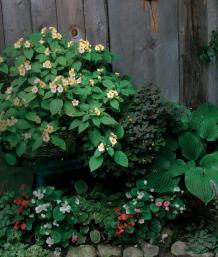
Creating beauty where least expected has been one of the most rewarding and exciting experiences of a long gardening life. We recently bought and renovated an old one-room schoolhouse on 10 neglected acres in the foothills of the Adirondacks. The entire property was embowered in a weedy tangle of buckthorns, swamp cedars, pines, wild grapevines, and Virginia creepers. Waving his arm toward a dark, gloomy jungle of nonflowering ditch lilies and moss that hugged the base of the building, my husband, Jigs—architect of grand visions—declared that we should make this area our entryway.
It was in these unpromising, damp conditions that I struggled to create a bright planting, not only for its own sake but also as a sign to visitors that this was the way to the front door. Except for moss and ferns, what could grow in such a forbidding place? Over the next few years, I struggled to find a winning strategy.
As I explored the range of possibilities among flowering plants that could take my inhospitable conditions in stride, I learned that every damp-shade area is different, so strategies for developing them vary, as do the plants that will grow there. The perennials and annuals I rely on bring abundant light-bearing flowers to unpromising sites around our property from spring through fall.
Fusion™ Glow isn’t the same old impatiens
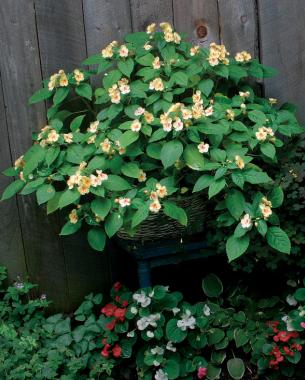
Impatiens (Impatiens walleriana and cvs., annual) have always seemed boring to me, but the Fusion™ series is so different that it belongs in another category altogether. Fusion™ Glow is my favorite of the bunch. Its large flowers, shaped more like orchids than flat-faced traditional types, are five petaled and slightly cupped, with the fifth one almost boatlike in shape. The bottom two petals, marked orange at their base, guide hummingbirds to the large, spurred nectar cup in the flower’s center. This remarkable hybrid is a vigorous plant that grows 12 inches tall by 15 inches wide with a mounding form. By midsummer, Fusion™ Glow impatiens transform the entryway bed, lighting it up with hundreds of soft yellow blooms that keep going until the first frost.
I grow this impatiens as a short hedge, as a specimen, and in a container. Except for occasional watering during very hot spells and fertilizing twice during the summer—the same tretment I give other damp-shade annuals—it is low maintenance.
Yellow foxglove provides soft summer color
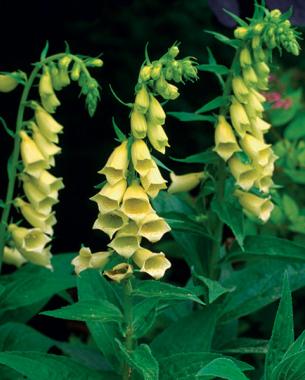
Originating in mountainous woodland and stony habitats from Europe to western Asia, yellow foxglove ( Digitalis grandiflora , USDA Hardiness Zones 3–8) is tolerant of dry shade but flourishes with moisture. Arising in midsummer from neat clumps of fine-toothed foliage, a mass of soft yellow open bells, speckled brown inside, blooms along one side of a 3-foot-tall stem from a neat clump. Usually described as a perennial, it is more accurate to call it a short-lived perennial. If the flowering stalk is cut down after blooms have faded, it may rebloom in the fall. When a few flower stalks are left, the plant self-seeds. It grows at the edge of light woodland against the weathered boards of our woodshed. Yellow foxglove, like all species in this genus, contains poisonous properties and should never be eaten. Deer will avoid it.
‘Super Olympia Mix’ begonias are colorful and low maintenance
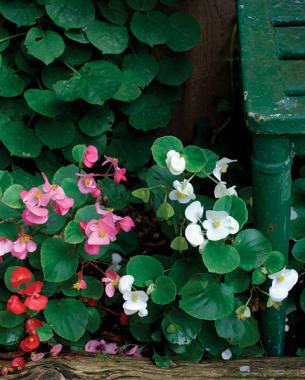
Begonias of any sort have never been high on my wish list, but in a desperate search to bring color to damp shade, I picked up some ‘Super Olympia Mix’ begonias (Begonia ‘Super Olympia Mix’, Zone 11) at a local nursery. I fell in love with this fibrous-rooted begonia for its profuse, cheerful bloom and easygoing way. Foliage, small, rounded, and glossy, sets off prolific miniature, roselike blooms. No deadheading is required. ‘Super Olympia’ is an improved form of the original ‘Olympia’ series: earlier blooming with larger flowers in brighter colors and with better overall performance.
I planted my mix of red, rose, pink, and white around the feet of an old, narrow, metal table that I picked up at a junkyard to hold containers (strategically placed tubs of flowers go far to lighten damp shade). I watered the plants at first, then left them alone to fend for themselves. They didn’t mind at all. They are just as easy to tend to when overwintering on a windowsill.
‘The Rocket’ ligularia sends blooms soaring to the sky
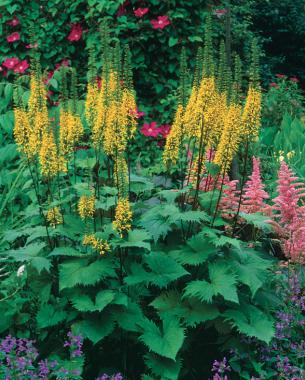
I knew nothing about ligularias when we moved to the schoolhouse, but I soon began to appreciate their virtues. The aptly named ‘The Rocket’ (Ligularia stenocephala ‘The Rocket’, Zones 4–8) is virtually indestructible if given moist ground and protection from the sun, the dominant characteristics of damp shade. In spring, green dentate foliage unfurls to form an attractive mound. Flowering begins in midsummer when stalks packed with little buds rise up to 4 feet tall. Little golden daisies, opening from bottom to top, shoot upward like rockets to the sky. My only complaint is that ‘The Rocket’ is slow spreading. Start with three plants to make a good show. In my garden, it likes the company of wild viburnums, native ferns, and flowering raspberry (Rubus odoratus, Zones 3–7).
Dwarf Chinese astilbe looks great among rocks
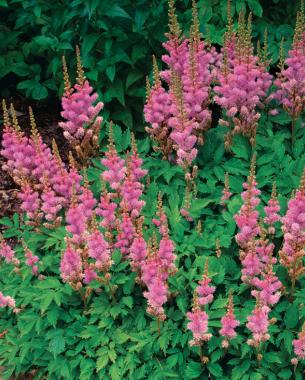
Dwarf Chinese astilbe ( Astilbe chinensis ‘Pumila’, Zones 4–8) is more tolerant of dry conditions than other astilbes but does best with steady moisture. When a friend first planted ‘Pumila’, he was disappointed. It was lost in his garden where the ground-hugging green leaves seemed to disappear in the shade. Then he noticed that this little astilbe looks great and thrives among rocks and beside stepping-stones, where the plant draws moisture and shows off its intricately cut foliage. I grow dwarf Chinese astilbe as a ground cover to bridge an area between a dry woodland bed and a damp-shade planting at the base of our storage shed. In midsummer, it sends up fluffy, cone-shaped plumes of light purple–pink flowers, bringing the height of the plant to 10 inches. Although it grows by rhizomes, dwarf Chinese astilbe isn’t unpleasantly aggressive and can be controlled easily. This is a tough little plant you can count on.
‘Zinfandel’ oxalis looks delicate but makes an impact
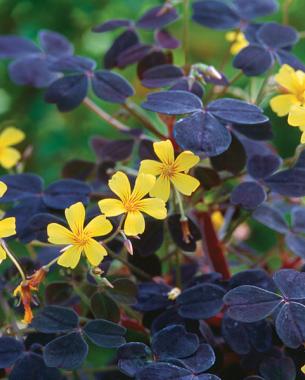
The old-fashioned shamrock houseplant is now high fashion. Several introductions from Proven Winners push this group to the fore for its elegant foliage; abundant, delicate flowers; and vigor. The first one I grew was fibrous-rooted ‘Zinfandel’ (Oxalis vulcanicola ‘Zinfandel’, Zones 9–11). Only 6 to 10 inches high with a spread to 12 inches, this plant’s tiny, ¾-inch-wide, bronze-colored leaf clusters and bright yellow flowers are massed on trailing stems that spill over the sides of shaded window boxes and containers. Though this shamrock is frost tender, it is easy to overwinter indoors.
False solomon’s seal is a native treasure
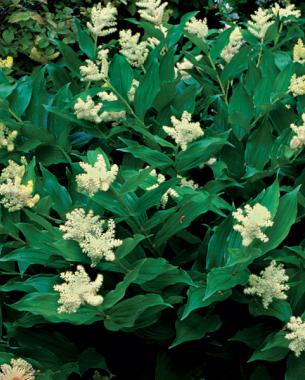
One of our most undervalued native plants, false Solomon’s seal ( Smilacina racemosa , Zones 4–9) is unrivaled for difficult shade. This graceful plant tolerates dry conditions and some sun but attains its full beauty in rich, moist soil and shade. Plants grow from thickened rhizomes in the same way as real Solomon’s seals ( Polygonatum spp. and cvs., Zones 3–9). When both emerge in spring, their shoots look alike, but when false Solomon’s seal blooms a little later, the difference between the two is apparent. False Solomon’s seal’s fluffy, cream-colored plumes, which are 6 to 12 inches long, hang downward from the top leaf of arching stems, while Solomon’s seal’s flowers—small white bells—grow along the stem. By fall, false Solomon’s seal’s soft plume is transformed into numerous clusters of translucent red berries sought by flower arrangers.
‘Hermann’s Pride’ lamium is no bully
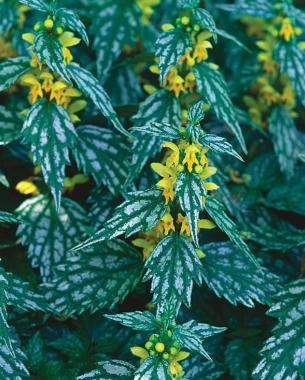
Unlike the rampantly creeping variegated yellow lamium (Lamium galeobdolon ‘Variegatum’), the lamium cultivar ‘Hermann’s Pride’ (Zones 4–8) is a slow-growing, clump-forming treasure that grows like a small bush, beautiful in foliage and flower. Ever-fresh leaves are jagged edged and etched with silver. Masses of bright, yellow-lipped flowers complement the foliage in late spring to early summer. In our entryway border, it is a handsome counterpoint to elegant white-flowered bleeding heart (Dicentra spectabilis f. alba, Zones 3–9), the wild bleeding heart (D. eximia, Zones 3–8), and assorted hostas.

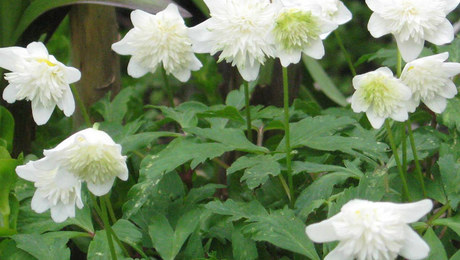
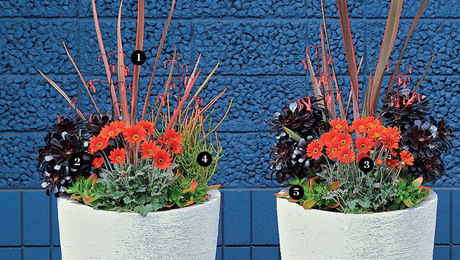
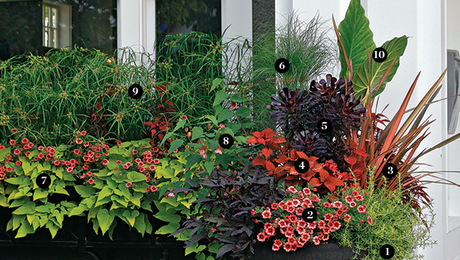
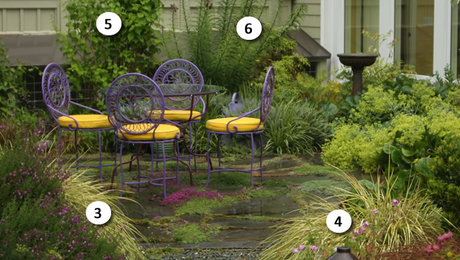













Comments
Log in or create an account to post a comment.
Sign up Log in